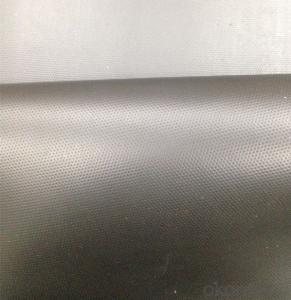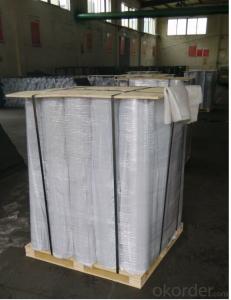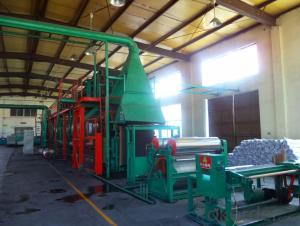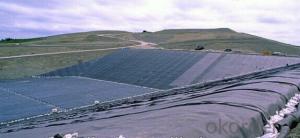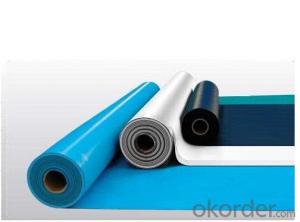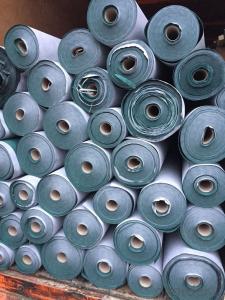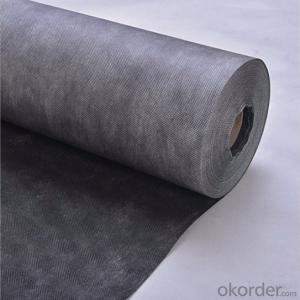EPDM Rubber Membrane Waterproof Prodcuts Roll
- Loading Port:
- Qingdao
- Payment Terms:
- TT OR LC
- Min Order Qty:
- 3000 m²
- Supply Capability:
- 200000 m²/month
OKorder Service Pledge
OKorder Financial Service
You Might Also Like
EPDM Rubber Waterproof Membrane
Product Instruction:
EPDM rubber waterproof membrane is made from ternary ethylene-propylene rubber,which is designed for waterproofing of exposed and non-exposed applications. EPDM waterproof membrane is of high elasticity among high polymer waterproof materials and becomes a world-popular waterproofing material.
CNBM own the wold-advanced equipment of cold feeding extrusion and continuous vulcanization technology. With the best performance among high polymer waterproof materials, EPDM is of exceptional elasticity and will not split or cracked under normal building movement.
Product Features:
-Excellent weather-ability, durability and size stability
-Good adaptability to high and low temperature, UV resistant and anti-corrosion
-High tensile strength and good elongation, accommodating to structure movement
-Easy installation, solid joint, and mo environmental pollution
-Good rooting penetration resistance
-Service life up to 50 years
Applications:
-Roof, basement, tunnel, pond liner, dam
-Industrial and civil building waterproofing
-Geosynthetic liner for fish ponds, swimming pools, channels, irrigation system
-Especially suitable for projects with high requirement in durability, anti-corrosion and deformation
Specifications:
-Width of roll: 1.2m, 2m, 4m
-Length of roll: 20m, 30m or customized
-Thickness of membrane: 1.2mm, 1.5mm, 2mm
-Type: vulcanized EPDM or welding EPDM
-Application: roof, basement, pond, lake, swimming pool, steel structure roofing, underground, tunnel, etc
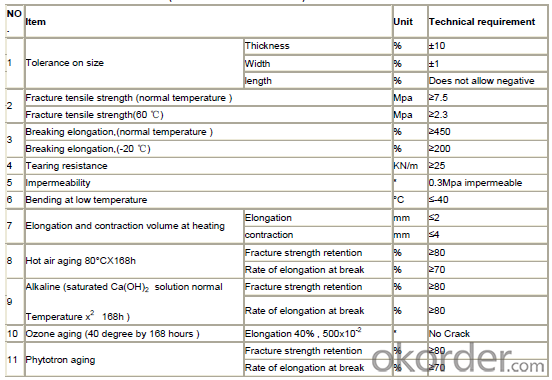
FAQ:
1. Is your EPDM waterproof membrane the real rubber?
Yes, our EPDM membrane is made from top quality rubber, which is imported from America. We support samples for testing, or testing in our factory.
2. How's your products quality?
Our EPDM is with the top quality at home and abroad. Our quality is much higher than Chinese standard. Our product is widely used in Chinese Central government projects. And it's also accpted by customers all over the world, such as EU, USA, Astrulia, etc.
3. What's the service life of your EPDM membrane?
The service life of our EPDM membrane is more than 50 years.
4.What's your MOQ?
Our MOQ is 3000M2.
5. What's your product ability of EPDM membrane?
We own the largest EPDM production line in China. Our product ability of EPDM membrane reaches 2 million square meter per year.
Photos:
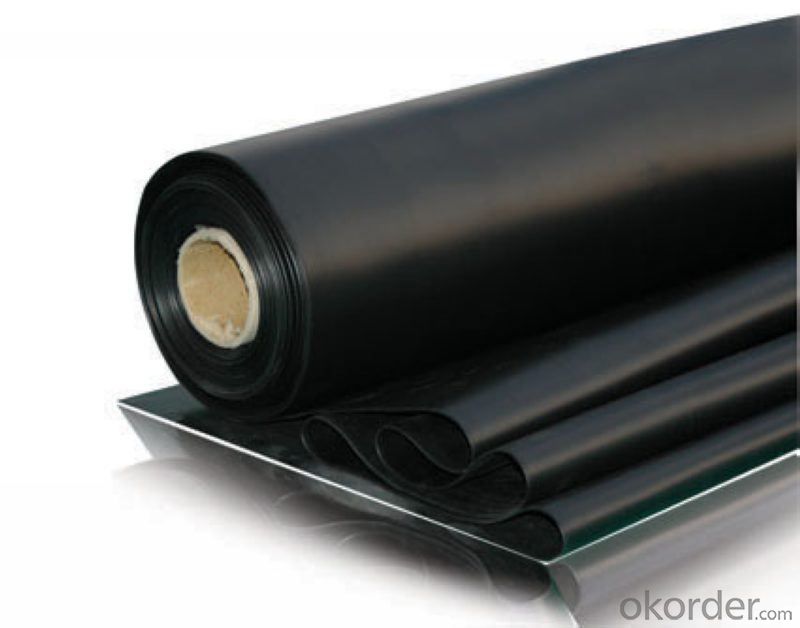
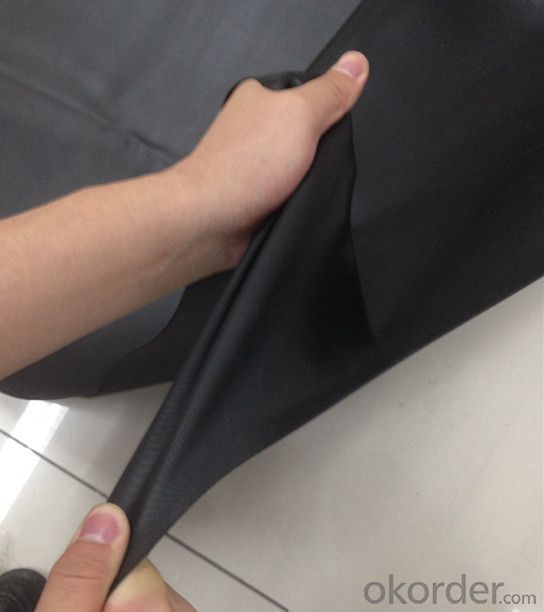


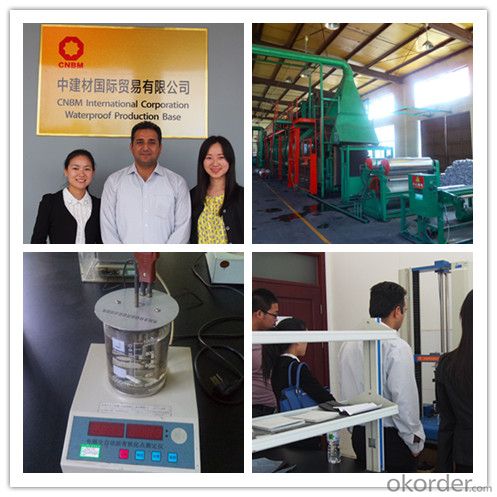
- Q:Can a waterproofing membrane be installed on metal surfaces?
- Yes, a waterproofing membrane can be installed on metal surfaces. There are various types of waterproofing membranes available, including those specifically designed for metal substrates. These membranes are often made of materials such as PVC, TPO, or EPDM, which are flexible and can adhere well to metal surfaces. The installation process typically involves cleaning and preparing the metal surface, applying a primer if necessary, and then applying the waterproofing membrane using adhesive or heat welding techniques. This provides a protective barrier against water infiltration and helps to prevent corrosion and damage to the metal surface. It is important to ensure that the chosen waterproofing membrane is compatible with the specific type of metal being used and that proper installation procedures are followed to achieve effective waterproofing.
- Q:Where are waterproofing membranes commonly used?
- Waterproofing membranes find wide application in various scenarios, serving to thwart water infiltration and safeguard structures against moisture-induced harm. The prevalent areas where they are employed include: 1. Basements: Waterproofing membranes are extensively utilized in basements to counter water seepage via foundation walls and floors. They establish a barrier that repels water, thereby promoting a dry and inhabitable space. 2. Roofs: Roofs often make extensive use of waterproofing membranes to shield buildings against rain, snow, and other adverse elements. Positioned beneath the roofing materials, they act as a barricade, averting water penetration and ensuring roof integrity. 3. Bathrooms and wet areas: Bathrooms, showers, and other wet regions necessitate the presence of waterproofing membranes to prevent water intrusion into walls and floors. By creating an impermeable seal, they effectively thwart the growth of mold, water damage, and structural complications. 4. Balconies and terraces: Balconies, terraces, and other outdoor spaces commonly benefit from the application of waterproofing membranes. Their presence safeguards against water-induced deterioration by constituting a protective layer that bars water penetration. 5. Swimming pools: Swimming pool construction heavily relies on waterproofing membranes to prevent water leakage. By being applied to the pool shell, they provide a water-tight seal, ensuring structural integrity and preventing water seepage. 6. Tunnels and underground structures: Tunnels and underground structures employ waterproofing membranes to shield against groundwater infiltration. These membranes serve as a waterproof barrier, effectively preventing water damage and structural compromise. 7. Planter boxes and green roofs: Planter boxes and green roofs often incorporate waterproofing membranes to avert water seepage into building structures. By establishing a barrier, they retain moisture within the planter or green roof while blocking infiltration into the building. In summary, waterproofing membranes assume a vital role in diverse construction endeavors, safeguarding structures, and prolonging their lifespan by curtailing water damage and moisture-related issues.
- Q:Can a waterproofing membrane be applied on vertical surfaces?
- Yes, a waterproofing membrane can be applied on vertical surfaces. In fact, waterproofing membranes are often used on vertical surfaces such as exterior walls, retaining walls, and foundations to prevent water penetration and protect the underlying structure. These membranes are specifically designed to adhere to vertical surfaces and create a barrier against moisture. They are typically applied in multiple layers to ensure maximum waterproofing effectiveness. Additionally, there are various types of waterproofing membranes available, including liquid-applied, sheet-applied, and spray-applied membranes, which can be tailored to different vertical surfaces and construction requirements.
- Q:Can a waterproofing membrane be used for plant rooms and mechanical equipment areas?
- Yes, a waterproofing membrane can be used for plant rooms and mechanical equipment areas. Plant rooms and mechanical equipment areas often require waterproofing to protect the equipment and surrounding structures from water damage. A waterproofing membrane is a commonly used solution for this purpose. It creates a barrier that prevents water from penetrating into the plant rooms and mechanical equipment areas, ensuring that the equipment remains dry and protected. The waterproofing membrane also helps to prevent moisture-related issues such as mold and mildew growth, which can be detrimental to the operation of the equipment and the overall functionality of the plant room. Overall, using a waterproofing membrane in plant rooms and mechanical equipment areas is a reliable and effective way to ensure the longevity and performance of the equipment and structures.
- Q:How does a waterproofing membrane ensure a watertight seal around penetrations?
- A waterproofing membrane ensures a watertight seal around penetrations by providing a barrier that prevents water from entering through these openings. The membrane is typically made of materials such as rubber, PVC, or bitumen, which are inherently water-resistant. When applied correctly, the waterproofing membrane is installed around penetrations such as pipes, drains, or vents, creating a sealed layer that acts as a protective barrier. The membrane is typically adhered or mechanically attached to the substrate, ensuring a secure and tight bond. The membrane is designed to be flexible, allowing it to conform to the shape of the penetration. This flexibility ensures that there are no gaps or spaces where water can seep through. Additionally, the membrane is often reinforced with a layer of fabric or mesh, enhancing its strength and durability. To further ensure a watertight seal, specialized waterproofing accessories such as collars, flanges, or boots are used around the penetration. These accessories are designed to fit tightly around the pipes or other protrusions, providing an additional layer of protection against water infiltration. Overall, a waterproofing membrane creates a reliable barrier that prevents water from entering through penetrations. It effectively seals off potential entry points, ensuring a watertight environment and protecting the underlying structure from water damage.
- Q:How does a waterproofing membrane adhere to a surface?
- A waterproofing membrane adheres to a surface through the use of special adhesives or sealants that are specifically designed to bond with the material of the surface. These adhesives create a strong and durable bond between the membrane and the surface, ensuring that it remains securely in place and effectively prevents the penetration of water or moisture.
- Q:Can a waterproofing membrane be used for a deck?
- Certainly! A deck can indeed benefit from the utilization of a waterproofing membrane. These membranes are frequently employed to shield surfaces from water-related harm by forming a barrier that hinders water infiltration. In the case of a deck, the application of a waterproofing membrane can effectively impede water seepage into the underlying structure, thereby averting issues like decay, distortion, and other types of damage. It is imperative to select a waterproofing membrane specifically crafted for outdoor usage, capable of enduring various elements such as UV rays, temperature fluctuations, and considerable foot traffic. Furthermore, the proper installation and maintenance of the waterproofing membrane on the deck play a pivotal role in ensuring its efficacy and prolonged lifespan.
- Q:Can a waterproofing membrane be used in geotechnical applications?
- Yes, a waterproofing membrane can be used in geotechnical applications. It is commonly used to prevent water infiltration in structures such as tunnels, retaining walls, and basements. The membrane acts as a barrier, effectively sealing the structure and protecting it from water damage.
- Q:Can a waterproofing membrane be used on flat roofs?
- Flat roofs can indeed benefit from the use of a waterproofing membrane. This method is widely recognized as one of the most effective and commonly used techniques for achieving waterproofing on flat roofs. The membrane itself is a thin material that is carefully applied to the roof's surface in order to prevent any water from seeping through. Typically constructed from durable and flexible substances like synthetic rubber or modified bitumen, the membrane is designed to withstand harsh weather conditions and offer long-lasting protection. By installing the membrane in overlapping layers, a continuous barrier is created that effectively seals the roof, preventing any water leakage into the building. Additionally, it is worth noting that waterproofing membranes can also provide insulation and energy efficiency advantages, which further contributes to their popularity in flat roof applications.
- Q:Can a waterproofing membrane be used on TPO roofs?
- TPO roofs, known for their durability and energy efficiency, can still experience leaks and water damage over time. To address this, a waterproofing membrane can be applied to enhance the waterproofing capabilities of a TPO roof. A waterproofing membrane is a thin layer of material that prevents water infiltration. It is typically made from synthetic materials like modified bitumen, EPDM, or PVC. These membranes effectively create a barrier against water, protecting the underlying roof structure from leaks and potential damage. When applying a waterproofing membrane on a TPO roof, it is crucial to ensure compatibility between the materials. The membrane must be specifically designed for TPO roofs and approved by the TPO roofing system manufacturer. This ensures compatibility and avoids adverse reactions or voided warranties. Installing a waterproofing membrane on a TPO roof involves surface cleaning and preparation, applying primer if needed, and adhering the membrane using an appropriate adhesive or heat welding method. Once installed, the membrane acts as an additional protective layer, preventing water from penetrating the TPO roof system and causing damage. In conclusion, a waterproofing membrane can be utilized on TPO roofs to enhance waterproofing and safeguard against leaks. However, it is vital to select a membrane designed for TPO roofs and approved by the manufacturer. Proper installation and regular maintenance are essential to maximize the longevity and effectiveness of the waterproofing membrane on a TPO roof.
1. Manufacturer Overview |
|
|---|---|
| Location | |
| Year Established | |
| Annual Output Value | |
| Main Markets | |
| Company Certifications | |
2. Manufacturer Certificates |
|
|---|---|
| a) Certification Name | |
| Range | |
| Reference | |
| Validity Period | |
3. Manufacturer Capability |
|
|---|---|
| a)Trade Capacity | |
| Nearest Port | |
| Export Percentage | |
| No.of Employees in Trade Department | |
| Language Spoken: | |
| b)Factory Information | |
| Factory Size: | |
| No. of Production Lines | |
| Contract Manufacturing | |
| Product Price Range | |
Send your message to us
EPDM Rubber Membrane Waterproof Prodcuts Roll
- Loading Port:
- Qingdao
- Payment Terms:
- TT OR LC
- Min Order Qty:
- 3000 m²
- Supply Capability:
- 200000 m²/month
OKorder Service Pledge
OKorder Financial Service
Similar products
New products
Hot products
Hot Searches
Related keywords

